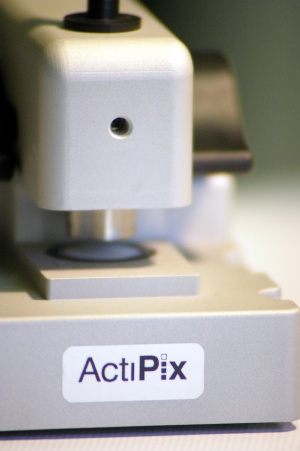Apr 23 2009
A new applications note from Paraytec describes how the ActiPix D-100 UV Area Imaging detector provides a novel technique for testing biocatalyst substrate specificity towards a mixture of UV active compounds using a continuous engagement electrophoretically mediated microanalysis (EMMA) assay method.

In the described application - a plug of the substrates was injected into a fused silica capillary column containing the background electrolyte and dissolved enzyme. Using a capillary electrophoresis instrument with the ActiPix D-100, the components are seen to be separated in the initial part of the run, avoiding competitive binding and inhibition problems that occur in standard enzyme assays.
Experimental data is shown that demonstrates how the EMMA assay using the ActiPix and a silica capillary with 3 loops uniquely enables multi-component substrate specificity analysis for the tyramine oxidase enzyme. The peaks corresponding to each of the separated components were measured at multiple time points along the looped capillary, providing intrinsic self-referencing and enabling ready identification of tyramine and 2-phenylethylamine as the only reactive components. The new method provides a quick, easily integrated technique for assessing enzyme-substrate specificity using a multi-compound mixture of substrates and had the potential to be broadly applicable to other UV active compounds. The method only requires minimal amounts of reagent, making it perfectly suited for evaluating enzyme specificity even if only nanolitre amounts of enzyme are available.
A copy of the Application Note (AN002) can be downloaded from www.paraytec.com/downloads/.
The ActiPix D100 is the world's first quantitative UV area imaging system. The miniature detector contains a high resolution 1280x1024 Active Pixel sensor. Compact in design, the ActiPix D100 consists of a control box connected via a fibre optic cable and communications cable to a remote sensor head. The sensor head holds easily exchangeable, application-specific cartridges. The cartridges are used in conjunction with powerful software, enabling the end-user to easily switch between applications. The detector can be used as a 'plug and play' accessory linked in-line to single or multiple peripheral devices, such as syringe pumps, existing CE or nanoLC instrumentation. These can be further coupled to other devices such as mass spectrometers giving a greater depth of information. Detection is performed at a selected wavelength by means of interchangeable filters. The detector wavelength range is 190 to 1100 nm.
Paraytec Ltd is a scientific instrument company based in York, UK, designing, developing and manufacturing innovative detectors. Paraytec was established in January 2005 as a spin-out from the Chemistry Department at the University Of York, UK. Winner of the prestigious PittCon Editors Silver Award and an R&D 100 Award in 2007, the ActiPix D-100 has achieved widespread recognition as a novel analytical instrument delivering applications advances.